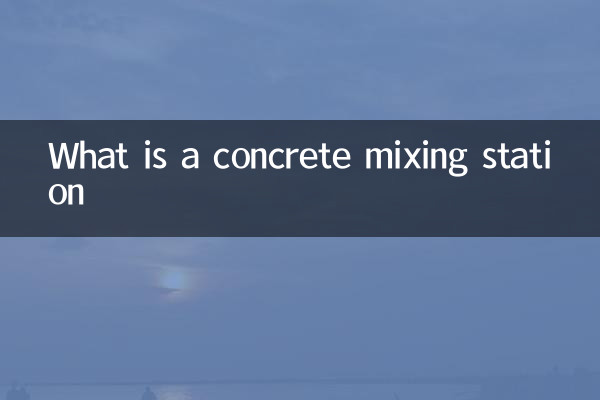What is a concrete mixing station
Concrete mixing station is a professional equipment used to produce concrete in construction projects. It mixes raw materials such as cement, aggregate (sand, stone), water and admixtures in proportion to make a uniform concrete mixture. It is widely used in housing construction, roads and bridges, water conservancy projects and other scenarios, and is one of the core facilities of modern industrial construction. This article will combine the hot topics on the Internet in the past 10 days to systematically introduce concrete mixing stations from the aspects of structure, classification, market data, etc.
1. Basic structure of concrete mixing station

Concrete batching plants usually consist of the following core modules:
| module name | Function description |
|---|---|
| Material storage system | Used to store cement, aggregate and other raw materials, including silos and aggregate bins. |
| Metering system | The proportion of each raw material is precisely controlled through sensors. |
| Mixing host | The core equipment, forced or self-falling mixer completes the mixing. |
| control system | Automated operation, supports remote monitoring and data logging. |
| Conveyor system | The belt or screw conveyor delivers the raw materials to the mixing host. |
2. Classification of concrete mixing stations
According to production capacity and usage scenarios, mixing stations can be divided into the following types:
| Classification criteria | Type | Features |
|---|---|---|
| production capacity | Small (≤60m³/h) | Suitable for rural construction or temporary projects. |
| production capacity | Medium size (60-120m³/h) | Commonly used in urban building construction. |
| production capacity | Large (≥120m³/h) | Used in large-scale infrastructure projects such as high-speed rail and reservoirs. |
| Mobility | Fixed | Long-term fixed installation, stable production capacity. |
| Mobility | Mobile | It can be quickly disassembled and assembled, and has high flexibility. |
3. Hot topics in concrete mixing stations in the past 10 days
Combined with the search data of the entire network, the following are the recent focuses of the industry:
| topic | heat index | Main content |
|---|---|---|
| Environmentally friendly mixing station upgrade | ★★★★★ | Policies in many places require the installation of dust removal and wastewater recycling systems. |
| Intelligent transformation | ★★★★☆ | AI algorithm optimizes the ratio and reduces energy consumption by 10%-15%. |
| Overseas market expansion | ★★★☆☆ | The export volume of mixing stations in “One Belt and One Road” countries increased by 23%. |
| Raw material price fluctuations | ★★★☆☆ | Rising cement costs are forcing companies to innovate in technology. |
4. Market data of concrete mixing stations (latest in 2024)
| indicator | numerical value | year-on-year growth |
|---|---|---|
| global market size | $7.8 billion | 4.5% |
| China market share | 35% | 6.2% |
| Automation penetration rate | 62% | 8% |
5. Future development trends
1.Greening: Zero-emission mixing stations will become a mandatory policy requirement.
2.Intelligent: 5G+Internet of Things enables remote diagnosis and predictive maintenance.
3.Modular design: Shorten the installation cycle to within 72 hours.
4.Special concrete: Demand for fiber-reinforced, self-healing concrete is rising.
To sum up, the concrete mixing station is not only the cornerstone of construction industrialization, but its technological evolution is also closely related to the wave of environmental protection and digitalization. In the future, efficient, low-carbon, and intelligent mixing stations will reshape the industry ecology.

check the details

check the details